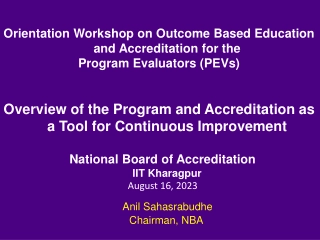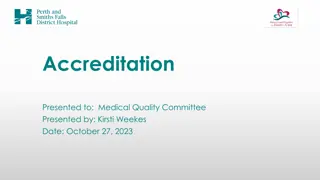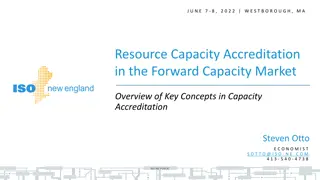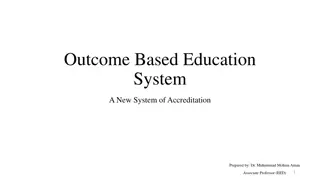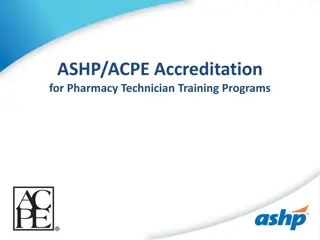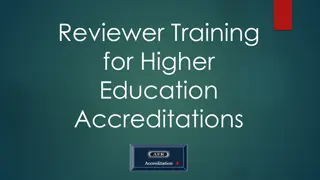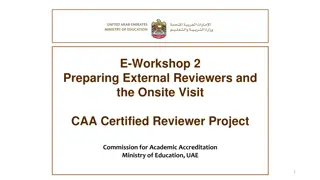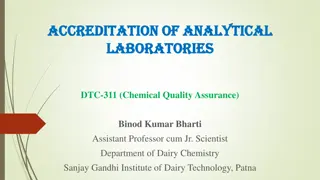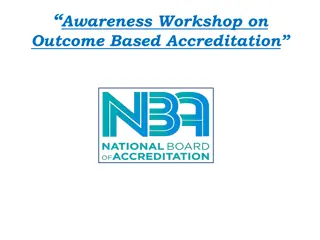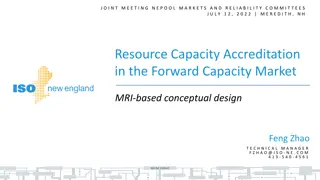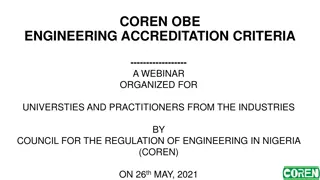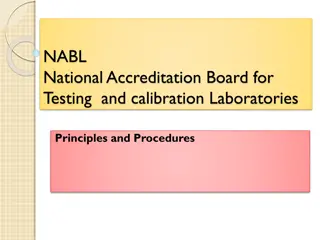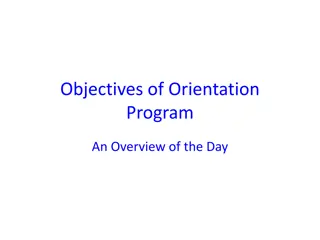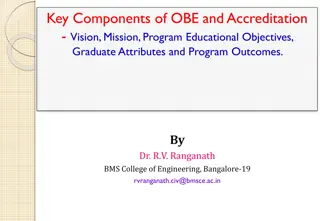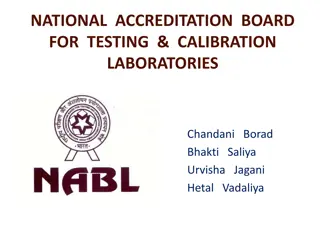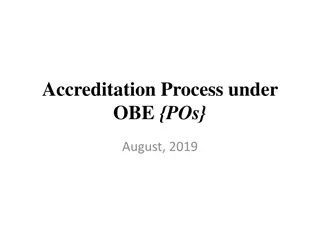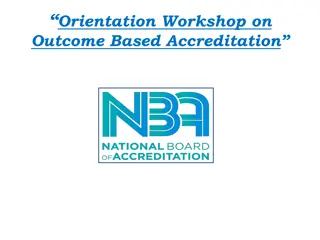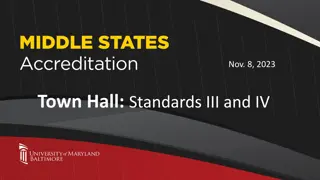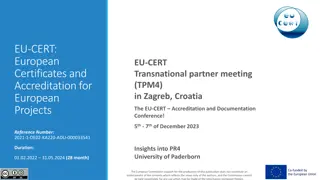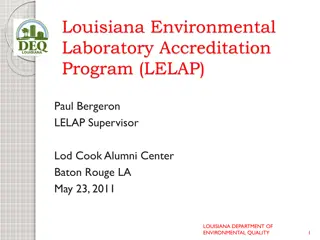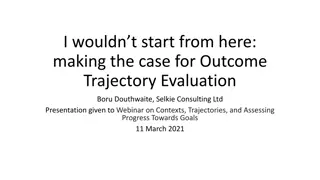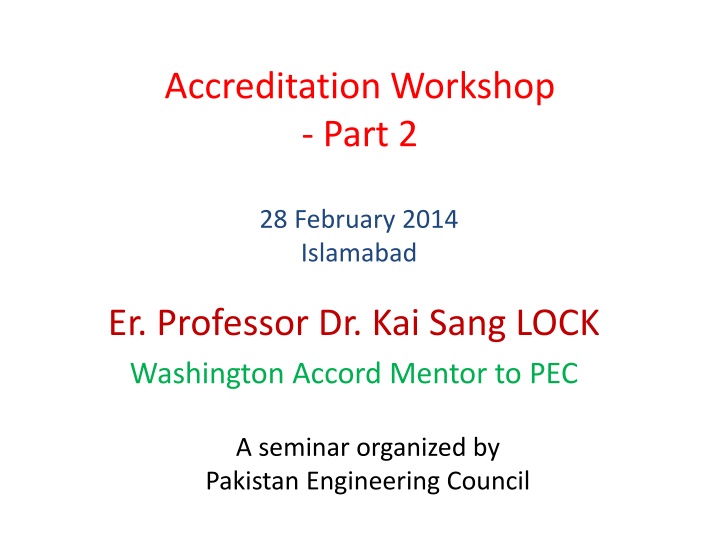
Outcomes-Based Assessment in Engineering Program Accreditation
Learn about outcomes-based assessment in engineering program accreditation, including key features, traditional approaches, and the emphasis on measurable outcomes rather than inputs. Discover how outcomes are stipulated, documented, and assessed to ensure program quality and effectiveness.
Download Presentation

Please find below an Image/Link to download the presentation.
The content on the website is provided AS IS for your information and personal use only. It may not be sold, licensed, or shared on other websites without obtaining consent from the author. If you encounter any issues during the download, it is possible that the publisher has removed the file from their server.
You are allowed to download the files provided on this website for personal or commercial use, subject to the condition that they are used lawfully. All files are the property of their respective owners.
The content on the website is provided AS IS for your information and personal use only. It may not be sold, licensed, or shared on other websites without obtaining consent from the author.
E N D
Presentation Transcript
Accreditation Workshop - Part 2 28 February 2014 Islamabad Er. Professor Dr. Kai Sang LOCK Washington Accord Mentor to PEC A seminar organized by Pakistan Engineering Council
Part 2 Implementing Outcomes-based Assessment & Preparing for Program Accreditation
Understanding Outcome-Based Assessment (OBA)
TRADITIONAL APPROACH FOR QUALITY ASSURANCE OF ENGINEERING PROGRAMMES Focused on the input & process quality The criteria for accreditation may typically include the following list: Organization and governance Financial resources Physical resources and facilities Faculty and staff Student intake quality Teaching learning process Co-curricular and extra-curricular activities Student services & counseling Research & Development Industrial interaction
Key features of OBA OBA focuses more on: Learning, as against teaching Students Outcomes, not inputs or capacity OBA incorporates continuous improvement to systematically analyze its systems for variance make decisions based on facts consciously define the organization s customers both internal and external actively seek input from customers
Outcomes-based system The emphasis is on measured outcomes rather than "inputs Outcomes include a range of skills and knowledge Outcomes are measurable, observable Outcomes (skills and knowledge) are specified, but not inputs Identifying appropriate and measurable outcomes is difficult, and often controversial
Outcomes Stipulate knowledge, skills, attitudes & behaviors on completion of program Well documented Defined by measurable performance indicators Both direct & indirect assessment tools to measure each outcome
Writing Intended Learning Outcomes Intended learning outcomes need to be written at both programme and course levels. Both of them need two essential elements: A statement of what content are the students expected to be able to do at the end of learning experience; The levels of understanding or performance in those content areas.
Definition of terms used Programme Educational Objectives Programme educational objectives are broad statements that describe the career and professional accomplishments that the programme is preparing graduates to achieve (within 3 to 5 years after graduation) Student Learning Outcomes Student learning outcomes are narrower statements that describe what students are expected to know and be able to do by the time of graduation. These relate to the skills, knowledge, and behaviours that students acquire in their matriculation through the programme
Definition of terms used Assessment Assessment is one or more processes that identify, collect, and prepare data to evaluate the achievement of programme educational objectives and student learning outcomes Evaluation Evaluation is one or more processes for interpreting the data and evidence accumulated through assessment practices. Evaluation determines the extent to which programme educational objectives or student learning outcomes are being achieved, and results in decisions and actions to improve the programme
Accreditation Criteria of relevance to Outcome-Based Assessment (OBA)
Accreditation Criteria 11 criteria in EAB Accreditation Manual: 1) Mission & Programme Educational Objectives 2) Student Learning Outcomes 3) Curriculum and Teaching/Learning Processes 4) Students 5) Faculty members 6) Facilities & learning environment 7) Institutional support & financial resources 8) Governance 9) Interaction between institution & industry 10) Research & development 11) Specific Programme criteria
Mission University mission? Faculty (school) mission & departmental mission statement? Alignment with mission of institution? Published and known to stake-holders?
Programme Education Objectives (PEO) Broad statements that describe what graduates are expected to attain within a few years after graduation Align with university s & engineering school s mission Well defined & documented & publicized Stakeholders participation, including faculty Manageable number of objectives Define outcomes Measurable Feedback mechanism for improvement
Programme Educational Objective (PEO) PEO consistent with mission? Alignment with mission of institution? Published and known to stake-holders? Based on needs of constituencies? Curriculum and processes that lead to attainment of PEO? Common mistakes in setting PEO Too broad and not specific to program Too narrow and similar to SLO Not known to stake-holders
Achievement of PEO Are assessment and evaluation processes in place to determine attainment of PEO? Is there a continuous improvement mechanism in place? Evidence and documentation is important.
Assessment of Programme Educational Objectives What graduates are expected to attain within a few years after graduation Ingredients to look out for: Objectives are current and relevant Methods and frequency to monitor if they are appropriate (usually every 2 to 3 yrs) Constituents involved is appropriate Student learning outcomes will enable its attainment Effective assessment processes in place to evaluate achievement Assessment method depends on factors like size of cohorts Methods can include data from advisory boards, recruiters, employers, graduate surveys
Student Learning Outcomes Student learning outcomes describe what students are expected to know and able to do by the time of graduation These relate to knowledge, skills, and behaviors that student acquire as they progress through the program Student learning outcomes to be stated and documented - in the form of graduate attributes Provide mapping of program SLO with EAB s SLO, if different Relationship of SLO to PEO
Table 2.1 : Mapping of Student Learning Outcomes to graduate attributes in EAB s Criterion 2(i) (a) to (j) Graduate attributes in EAB s 2(i) (a) to (j)* Educational institution s Student Learning Outcomes [if different from graduate attributes in Criterion 2(i) (a) to (j)] (1) Student learning outcome (..) (2) Student learning outcome ( ) (3) | (4) |
Assessment of Student Learning Outcomes Collect data to assess the level students have attained outcomes Evaluate results to assist in deciding how to improve teaching-learning processes Key features to take note: Assess performance of cohorts, not individual students For each outcomes, identify key performance indicators@ (concrete actions students is able to perform) Not necessary to collect data for every student in every course data collection needs to be representative Not necessary to have more than one data point to determine performance of an outcome Not necessary to assess every outcome every year Focus is on how data is used to understand strengths/weaknesses and continuous improvement @ Definition by ABET: Specific, measurable statements identifying the performance(s) required to meet the outcome; confirmable through evidence
Reference (from ABET) In program assessment planning, it is important to let common sense prevail. Example of how not having to assess every outcome every year:
Course Learning outcomes Course Learning Outcomes describe what a student should be capable of as a result of learning experiences within a course To be determined by the course instructor (s) Mapping course learning outcomes to SLO to show learning experience meets the accreditation criteria Each course may contribute to a list of SLOs, may contribute strongly to one or some SLOs and less strongly to other SLOs When a course may contribute to several SLOs, usually only a subset of its strong outcomes need to be used for EAB assessment
Defining Curriculum Objective and Intended Course Learning Outcomes A learning outcome is what a student can do as a result of a learning experience. It describes a specific task that student is able to perform at a given level of competence under a certain situation. The three broad types of learning outcomes are: Disciplinary knowledge and skills Generic skills Attitudes and values
Table 3.1: Curriculum and teaching processes to achieve Student Learning Outcomes, and evaluation method/criteria Student Learning Outcomes* Category# Module Evaluation method & criteria (1) (2) (3) (4) (5) (6) (7) --
Course Learning outcomes Course Learning Outcomes describe the complex performances a student should be capable of as a result of learning experiences within a course. These are determined by the course instructor (s) Mapping course learning outcomes to program outcomes and how overall learning experience meet the accreditation criteria
Contribution of each course Each undergraduate course in the department contributes to a list of SLOs. Usually, a course may contribute strongly to some EAB* SL outcomes and less strongly to other outcomes. While a course may contribute to several NBA SLOs, usually only a subset of its strong outcomes need to be used for EAB* assessment. *Adapted from: UCLA Electrical Engineering Department s Guide for instructors and teaching Assistants of undergraduate courses
Teaching-Learning Processes Each program should cover general and specialized professional content Adequate breadth and depth, and Appropriate components in Science and Humanities Evaluation of teaching-learning processes Modes of teaching-learning: lecture, tutorial, seminar, projects, internship, peer-group discussion, ..
Curriculum Does the curriculum satisfy the program specific criteria of the particular engineering discipline? Are performance indicators established to measure the outcomes of the courses with respect to the program outcomes of NBA criteria)? Major design experience? Prerequisites Course syllabi Cores and electives
Interaction between institution & industry Involvement of industry stake-holders to ensure relevance of curriculum Opportunity for students to acquire industrial experience via internships and design projects by professional engineers and faculty members with industrial experience Communication channel with industry, e.g. industry advisory board
Assessment & Demonstration of Achievement Breadth Depth Where gained Learning Process Assessment Methods
Abilities Knowledge (gathering & recall) Comprehending information Application (making use of knowledge) Analysis (taking apart) Synthesis (putting together) Evaluation (judging the outcome) Creation
Activities Action Verbs that provides evidence define, describe, identify, label, name, outline, reproduce, recall, select, state, present, be aware of, extract, organise, recount, write, recognise, measure, underline, repeat, relate, know, match. Knowing interpret, translate, estimate, justify, comprehend, convert, clarity, defend, distinguish, estimate, explain, extend, generalise, exemplify, give examples of, infer, paraphrase, predict, rewrite, summarise, discuss, perform, report, present, restate, identify, illustrate, indicate, find, select, understand, represent, name, formulate, judge, contrast, translate, classify, express, compare. Comprehension apply, solve, construct, demonstrate, change, compute, discover, manipulate, modify, operate, predict, prepare, produce, relate, show, use, give examples, exemplify, draw (up), select, explain how, find, choose, assess, practice, operate, illustrate, verify. Application of knowledge (understanding) recognise, distinguish between, evaluate, analyse, break down, differentiate, identify, illustrate how, infer, outline, point out, relate, select, separate, divide/subdivide, compare, contrast, justify, resolve, devote, examine, conclude, criticise, question, diagnose, identify, categorise, point out, elucidate. Analysis propose, present, structure, integrate, formulate, teach, develop, combine, compile, compose, create, devise, design, explain, generate, modify, organise, plan, rearrange, reconstruct, relate, reorganise, revise, write, summarise, tell, account for, restate, report, alter, argue, order, select, manage, generalise, precise, derive, conclude, build up, engender, synthesise, put together, suggest, enlarge. Synthesis Judge, appraise, assess, conclude, compare, contrast, describe how, criticise, discriminate, justify, defend, evaluate, rate, determine, criticise, choose, value, question. Evaluation
Blooms Taxonomy Cognitive Domain (modified by Anderson & Krathwohl) Creation Compare, decide Evaluation Design Synthesis Analyse Analysis Calculate Application Explain Comprehension List Knowledge (Remembering)
Ability/ competency Level Definition the remembering of previously learned material; it may involve the recall of a wide range of material from specific facts to complete theories, but all that is required is the bringing to mind of the appropriate information. Knowledge 1 the ability to grasp the meaning of material; may be shown by translating material from one form to another (words to numbers), by interpreting material (explaining or summarizing), and by estimating future trends (predicting consequences or effects); this goes one step beyond the simple remembering of material, and represent the lowest level of understanding 2 Comprehension the ability to use learned material in new, concrete situations; may include the application of rules, methods, concepts, principles, laws, and theories; requires a higher level of understanding than those under comprehension. Application 3 the ability to break down material into its component parts so that its organizational structure may be understood; may include the identification of parts, analysis of the relationship between parts, and recognition of the organizational principles involved; represents a higher level than comprehension and application because it requires an understanding of both the content and the structural form of the material. 4 Analysis the ability to put parts together to form a new whole; may involve the production of a unique communication, a plan of operations (research proposal), or a set of abstract relations (scheme for classifying information); stresses creative behaviors, with major emphasis on the formulation of new patterns or structure 5 Synthesis the ability to judge the value of material for a given purpose, based on definite criteria; contains elements of all the other categories, plus conscious value judgments based on clearly defined criteria. Evaluation 6 Creation 7
Assessment of SLO Assessment is big subject and probably the major challenge of the teaching faculty Are assessment methods adequate to provide evidence of achievement of SLO? Each learning outcome may be measured or evaluated in terms of performance indicators Is there a system in place to ensure that each student will acquire the stated SLO before graduation? (bearing in mind the various core and optional subjects available, and overseas attachment)
Sustainable Program Assessment Processes Direct and indirect methods of assessment to be applied to measure a wide variety of different student abilities Consider best fit between program needs, satisfactory validity and affordability (time, money and effort) Need to use multiple methods to maximise validity and reduce bias of any approach triangulation.
Assessment Assessment is one or more processes that identify, collect, and prepare data to evaluate the attainment of student learning outcomes and program educational objectives. Effective assessment uses relevant direct, indirect, quantitative and qualitative measures as appropriate to the objective or outcome being measured. Appropriate sampling method may be used as part of an assessment process.
Steps for assessment design 1) Define results to be measured 2) Identify data required and sources 3) Review existing assessment method 4) Define additional methods and measures 5) Implement & evaluate
Assessment Methods (Gloria Rogers) Locally developed examinations Oral exam Written surveys and questionnaires Commercial, norm-referenced, standardized exams Exit and other interview Focus groups External examiner Portfolios Simulations Performance appraisals
Examples of Assessment Methods in EC UK Exams Class tests Project reports Presentations Lab reports Design studies Vivas/orals Posters
Assessment tools and methods Formative assessment The collection of information about student learning during the progression of a course or program in order to improve students learning. Example: reading the first lab reports of a class to assess whether some or all students in the group need a lesson on how to make them succinct and informative.
Assessment tools and methods Summative assessment The gathering of information at the conclusion of a course, program, or undergraduate career to improve learning or to meet accountability demands. When used for improvement, impacts the next cohort of students taking the course or program. Examples: examining student final exams in a course to see if certain specific areas of the curriculum were understood less well than others; analyzing senior projects for the ability to integrate across disciplines.
Rubric A rubric is a set of criteria for assessing student work or performance. Rubrics are particularly suited to learning outcomes that are complex or not easily quantifiable, for which there are no clear right or wrong answers, or which are not evaluated with standardized tests or surveys. Assessment of writing, oral communication, critical thinking, or information literacy often requires rubrics.

